Metamorphic Conditions and Raman Spectroscopic Carbonaceous Material Thermometry of Host Schists of Olympiada and Eldorado Gold Deposits (Yenisey Ridge, Russia)
Abstract
:1. Introduction
2. Regional Geology and Metallogeny of the Yenisey Ridge
3. Geology of Deposits
4. Materials and Methods
5. Results
5.1. Petrography and Mineralogy
5.2. P-T Parameters of Metamorphism
5.3. Chlorite Thermometry
5.4. Raman Spectroscopy
5.5. Ar-Ar Dating
6. Discussion
6.1. P-T Conditions of Metamorphism
6.2. Carbonaceous Material Thermometry
6.3. Ar-Ar Dating
6.4. Correlation of the Mineralization Periods with the Main Tectonomagmatic Events
7. Conclusions
- (1)
- The host rocks of both Olympiada and Eldorado gold deposits are metamorphosed during the single episode of Barrovian-type metamorphism at similar temperatures 530–570 °C. The rocks do not indicate any traces of the early HT/LP metamorphism observed in other areas of the YK. The growth of the late chlorite after peak metamorphic minerals occurred at temperatures higher than 350 °C probably during retrograde metamorphism.
- (2)
- Carbonaceous material thermometry indicates a wide range of obtained temperatures around 90–150 °C for each sample. The highest temperatures are close to the peak metamorphic temperatures estimated by garnet-biotite thermometry. We guess that thermometry using Raman spectroscopy of carbonaceous material is a reliable tool for temperature estimates, but it can only be used if there is a sufficiently large number of analyzes.
- (3)
- The new 39/40Ar age data on ore-forming processes of the Eldorado deposit around 796 Ma are very close to the age of the Barrovian-type metamorphism estimated in the area under study and around the whole Yenisey ridge. This may indicate their genetic affinity.
- (4)
- The review of magmatic and metamorphic events and ore-forming processes of Yenisey ridge indicate that the most productive ore stage (gold-sulfide-quartz) have a good time correlation with the regional metamorphism of Barrovian type. This indicates that metamorphic processes can play a key role in forming of gold deposits of the Yenisey ridge.
Supplementary Materials
Author Contributions
Funding
Conflicts of Interest
References
- Large, R.R.; Bull, S.W.; Maslennikov, V.V. A Carbonaceous Sedimentary Source-Rock Model for Carlin-Type and Orogenic Gold Deposits. Econ. Geol. 2011, 106, 331–358. [Google Scholar] [CrossRef]
- Sazonov, A.M.; Lobanov, K.V.; Zvyagina, E.A.; Leontiev, S.I.; Silyanov, S.A.; Nekrasova, N.A.; Nekrasov, A.Y.; Borodushkin, A.B.; Poperekov, V.A.; Zhuravlev, V.V.; et al. Olympiada Gold Deposit, Yenisei Ridge, Russia. SEG Spec. Publ. 2020, 23, 203–226. [Google Scholar]
- Beyssac, O.; Goffe´, B.; Chopin, C.; Rouzaud, J.N. Raman spectra of carbonaceous material in metasediments: A new geothermometer. J. Metamorph. Geol. 2002, 20, 859–871. [Google Scholar] [CrossRef]
- Beyssac, O.; Bollinger, L.; Avouac, J.-P.; Goffe´, B. Thermal metamorphism in the lesser Himalaya of Nepal determined from Raman spectroscopy of carbonaceous material. Earth Planet. Sci. Lett. 2004, 225, 233–241. [Google Scholar] [CrossRef]
- Rantitsch, G.; Grogger, W.; Teichert, C.; Ebner, F.; Hofer, C.; Maurer, E.-M.; Schaffer, B.; Toth, M. Conversion of carbonaceous material to graphite within the Greywacke Zone of the Eastern Alps. Acta Diabetol. 2004, 93, 959–973. [Google Scholar] [CrossRef]
- Grew, E.S. Carbonaceous Material in Some Metamorphic Rocks of New England and Other Areas. J. Geol. 1974, 82, 50–73. [Google Scholar] [CrossRef]
- Pasteris, J.D.; Wopenka, B. Raman spectra of graphite as indicators of degree of metamorphism. Can. Mineral. 1991, 29, 1–9. [Google Scholar]
- Bibikova, E.V.; Gracheva, T.V.; Makarov, V.A.; Nozhkin, A.D. Age boundaries in geological evolution of the Early Precambrian of the Yenisey Ridge. Stratigr. Geol. Correl. 1993, 1, 35–40. (In Russian) [Google Scholar]
- Sukhorukov, V.; Turkina, O.; Tessalina, S.; Talavera, C. Sapphirine-bearing Fe-rich granulites in the SW Siberian craton (Angara-Kan block): Implications for Paleoproterozoic ultrahigh-temperature metamorphism. Gondwana Res. 2018, 57, 26–47. [Google Scholar] [CrossRef]
- Sukhorukov, V.; Turkina, O.; Tessalina, S.; Talavera, C. Orthopyroxene-sillimanitegranulites of the Angara-Kan block (SW Siberian craton): Constraints on timing of UHT metamorphism. J. Asian Earth Sci. 2021, 207, 104650. [Google Scholar] [CrossRef]
- Likhanov, I.I.; Nozhkin, A.D.; Reverdatto, V.V.; Kozlov, P.S. Grenvillian tectonic events and evolution of the Yenisei Ridge at the western margin of the Siberian craton. Geotektonics 2014, 48, 371–389. [Google Scholar] [CrossRef]
- Vernikovsky, V.; Metelkin, D.; Vernikovskaya, A.; Matushkin, N.; Kazansky, A.; Kadilnikov, P.; Romanova, I.; Wingate, M.; Larionov, A.; Rodionov, N. Neoproterozoic tectonic structure of the Yenisei Ridge and formation of the western margin of the Siberian craton based on new geological, paleomagnetic, and geochronological data. Russ. Geol. Geophys. 2016, 57, 47–68. [Google Scholar] [CrossRef]
- Nozhkin, A.D.; Borisenko, A.S.; Nevolko, P.A. Stages of the Late Proterozoic magmatism and ages of gold mineralization in the Yenisei Ridge. Russ. Geol. Geophys. 2011, 52, 158–181. [Google Scholar] [CrossRef]
- Vernikovsky, V.A.; Vernikovskaya, A.E. Tectonics and evolution of the granitoid magmatism in the Yenisei Ridge. Russ. Geol. Geophys. 2006, 47, 35–52. [Google Scholar]
- Konstantinov, M.; Cherkasov, S.; Dankovtsev, R.; Egorkin, A. Specific crustal features of large and superlarge endogenic gold deposits (Siberia and Far East regions). Glob. Tectonics Met. 1999, 7, 143–147. [Google Scholar] [CrossRef]
- Li, L.V. The Olympiada Disseminated Gold-Sulfide Deposit; KNIIGiMS: Krasnoyarsk, Russia, 2003; p. 120. (In Russian) [Google Scholar]
- Zabiyaka, A.I.; Kurgankov, P.P.; Gusarov, Y.V.; Samkov, V.V.; Zobov, N.E. Tectonics and Metallogeny of the Lower Angara Region; KNIIGiMS: Krasnoyarsk, Russia, 2004; p. 322. (In Russian) [Google Scholar]
- Serdyuk, S.S.; Komorovskiy, Y.E.; Zverev, A.I.; Oyaber, V.K.; Vlasov, V.S.; Babushkin, V.E.; Kirilenko, V.A.; Zemlyanskiy, S.A. Models of Gold Deposits in the Yenisei Area of Siberia; IGDGiG: Krasnoyarsk, Russia, 2010; p. 582. (In Russian) [Google Scholar]
- Likhanov, I.I.; Reverdatto, V.V.; Sheplev, V.S.; Verschinin, A.E.; Kozlov, P.S. Contact metamorphism of Fe- and Al-rich graphitic metapelites in the Transangarian region of the Yenisey Ridge, eastern Siberia, Russia. Lithos 2001, 58, 55–80. [Google Scholar] [CrossRef]
- Likhanov, I.I.; Reverdatto, V.V.; Kozlov, P.S.; Khiller, V.V.; Sukhorukov, V.P. Three metamorphic events in Precambrian P-T-t history of the TransangarianYenisey Ridge recorded in garnet grains in metapelites. Petrology 2013, 21, 561–578. [Google Scholar] [CrossRef]
- Likhanov, I.; Reverdatto, V.; Kozlov, P.; Khiller, V.; Sukhorukov, V. P–T–t constraints on polymetamorphic complexes of the Yenisey Ridge, East Siberia: Implications for Neoproterozoic paleocontinental reconstructions. J. Asian Earth Sci. 2015, 113, 391–410. [Google Scholar] [CrossRef]
- Likhanov, I.; Reverdatto, V. P–T–t constraints on the metamorphic evolution of the Transangarian Yenisei Ridge: Geodynamic and petrological implications. Russ. Geol. Geophys. 2014, 55, 299–322. [Google Scholar] [CrossRef]
- Likhanov, I.; Reverdatto, V.; Kozlov, P. Collision-related metamorphic complexes of the Yenisei Ridge: Their evolution, ages, and exhumation rate. Russ. Geol. Geophys. 2011, 52, 1256–1269. [Google Scholar] [CrossRef]
- Kachevsky, L.K.; Kachevskaya, G.I.; Grabovskaya, Z.M. Geological Map of the Yenisei Ridge on a Scale of 1:500,000; Mkrtychyan, A.K., Sherman, M.L., Eds.; Krasnoyarskgeols’emka: Krasnoyarsk, Russia, 1998. (In Russian) [Google Scholar]
- Zvyagina, E.A. Metamorphism and gold metallogeny of the Upper Enashimo ore cluster. Master’s Thesis, Siberian Federal University, Krasnoyarsk, Russia, 1989; p. 275. (In Russian). [Google Scholar]
- Likhanov, I.; Polyansky, O.P.; Reverdatto, V.V.; Memmi, I. Evidence from Fe- and Al-rich metapelites for thrust loading in the Transangarian region of the Yenisey Ridge, eastern Siberia. J. Metamorph. Geol. 2004, 22, 743–762. [Google Scholar] [CrossRef]
- Vernikovsky, V.A.; Vernikovskaya, A.; Kotov, A.; Sal’Nikova, E.; Kovach, V. Neoproterozoic accretionary and collisional events on the western margin of the Siberian craton: New geological and geochronological evidence from the Yenisey Ridge. Tectonophysics 2003, 375, 147–168. [Google Scholar] [CrossRef]
- Sazonov, A.M.; Ananyev, A.A.; Poleva, T.V.; Khokhlov, A.N.; Vlasov, V.S.; Zvyagina, E.A.; Fedorova, A.V.; Tishin, P.A.; Leontyev, S.I. Gold-ore metallogeny of the Yenisey Ridge: Geological-structural provincialism, structural types of ore fields. J. Sib. Fed. Univ. Eng. Technol. 2010, 4, 371–395. (In Russian) [Google Scholar]
- Vernikovskaya, A.E.; Vernikovsky, V.A.; Popov, N.V.; Yasenev, A.M.; Wingate, M.T.D. The oldest granitoids in the transangara region of the Yenisei Ridge: U-Th-Pb data on zircon. Dokl. Earth Sci. 2004, 397, 616–620. [Google Scholar]
- Gibsher, N.; Tomilenko, A.; Sazonov, A.; Bul’Bak, T.; Khomenko, M.; Ryabukha, M.; Shaparenko, E.; Sil’Yanov, S.; Nekrasova, N. Ore-bearing fluids of the Eldorado gold deposit (Yenisei Ridge, Russia). Russ. Geol. Geophys. 2018, 59, 983–996. [Google Scholar] [CrossRef]
- Yui, T.-F.; Huang, E.; Xu, J. Raman spectrum of carbonaceous material: A possible metamorphic grade indicator for low-grade metamorphic rocks. J. Metamorph. Geol. 1996, 14, 115–124. [Google Scholar] [CrossRef]
- Baksi, A.K.; Archibald, D.A.; Farrar, E. Intercalibration of 40Ar/39Ar Dating Standards. Chem. Geol. 1996, 129, 307–324. [Google Scholar] [CrossRef]
- Holdaway, M. Application of new experimental and garnet Margules data to the garnet-biotite geothermometer. Am. Miner. 2000, 85, 881–892. [Google Scholar] [CrossRef]
- Henry, D.; Guidotti, C.; Thomson, J. The Ti-saturation surface for low-to-medium pressure metapeliticbiotites: Implications for geothermometry and Ti-substitution mechanism. Am. Mineral. 2005, 90, 316–328. [Google Scholar] [CrossRef]
- Wu, C.-M.; Chen, H.-X. Revised Ti-in-biotite geothermometer for ilmenite- or rutile-bearing crustal metapelites. Sci. Bull. 2015, 60, 116–121. [Google Scholar] [CrossRef] [Green Version]
- Wu, C.-M.; Zhang, J.; Ren, L.-D. Empirical Garnet-Biotite-Plagioclase-Quartz (GBPQ) Geobarometry in Medium- to High-Grade Metapelites. J. Pet. 2004, 45, 1907–1921. [Google Scholar] [CrossRef] [Green Version]
- Kranidiotis, P.; MacLean, W.H. Systematics of chlorite alteration at the Phelps Dodge massive sulfide deposit, Matagami, Quebec. Econ. Geol. 1987, 82, 1898–1911. [Google Scholar] [CrossRef]
- Jowett, E.C. Fitting iron and magnesium into the hydrothermal chlorite geothermometer. In Proceedings of the Program with Abstracts 16, A62. GAC/MAC/SEG Joint Annual Meeting, Toronto, ON, Canada, 27–29 May 1991. [Google Scholar]
- McDowell, S.D.; Elders, W.A. Authigenic layer silicate minerals in borehole Elmore 1, Salton Sea Geothermal Field, California, USA. Contrib. Mineral. Petrol. 1980, 74, 293–310. [Google Scholar] [CrossRef]
- Cathelineau, M.; Nieva, D. A chlorite solid solution geothermometer the Los Azufres (Mexico) geothermal system. Contrib. Mineral. Petrol. 1985, 91, 235–244. [Google Scholar] [CrossRef]
- Bourdelle, F.; Parra, T.; Chopin, C.; Beyssac, O. A new chlorite geothermometer for diagenetic to low-grade metamorphic conditions. Contrib. Miner. Pet. 2013, 165, 723–735. [Google Scholar] [CrossRef]
- Wiewióra, A.; Weiss, Z. Crystallochemical classifications of phyllosilicates based on the unified system of projection of chemical composition: II. The chlorite group. Clay Miner. 1990, 25, 83–92. [Google Scholar] [CrossRef]
- Rahl, J.M.; Anderson, K.M.; Brandon, M.T.; Fassoulas, C. Raman spectroscopic carbonaceous material thermometry of low-grade metamorphic rocks: Calibration and application to tectonic exhumation in Crete, Greece. Earth Planet. Sci. Lett. 2005, 240, 339–354. [Google Scholar] [CrossRef]
- Likhanov, I.I.; Santosh, M. The ‘triple point’ paradigm of aluminosilicates revisited. Geol. J. 2020, 55, 4772–4789. [Google Scholar] [CrossRef]
- Nozhkin, A.D.; Likhanov, I.I.; Reverdatto, V.V.; Kozlov, P.S. Grenville orogeny, Late Neoproterozoic rift-related and intraplate magmatism at the western margin of the Siberian craton as geological evidence for the assembly and breakup of Rodinia. In Proceedins of the Rodinia 2013: Supercontinental Cycles and Geodynamics Symposium, Moscaw, Russia, 20–24 May 2013; Veselovskiy, R., Lubnina, N., Eds.; PERO Press: Moscow, Russia, 2013; p. 55. [Google Scholar]
- Luque, F.J.; Pasteris, J.; Wopenka, B.; Rodas, M.; Barrenechea, J.F. Natural fluid-deposited graphite; mineralogical characteristics and mechanisms of formation. Am. J. Sci. 1998, 298, 471–498. [Google Scholar] [CrossRef]
- Large, D.J.; Christy, A.G.; Fallick, A.E. Poorly crystalline carbonaceous matter in high grademetasediments: Implications of graphitization and metamorphic fluids compositions. Contrib. Mineral. Petrol. 1994, 116, 108–116. [Google Scholar] [CrossRef]
- Petrov, V.G. Gold Metallogeny of the Northern Yenisei Ridge; Nauka: Novosibirsk, Russia, 1974; p. 140. (In Russian) [Google Scholar]
- Sazonov, A.M. Geochemistry of Gold in Metamorphic Formations; Tomsk Polytechnical University Publishing: Tomsk, Russia, 1998; p. 166. (In Russian) [Google Scholar]
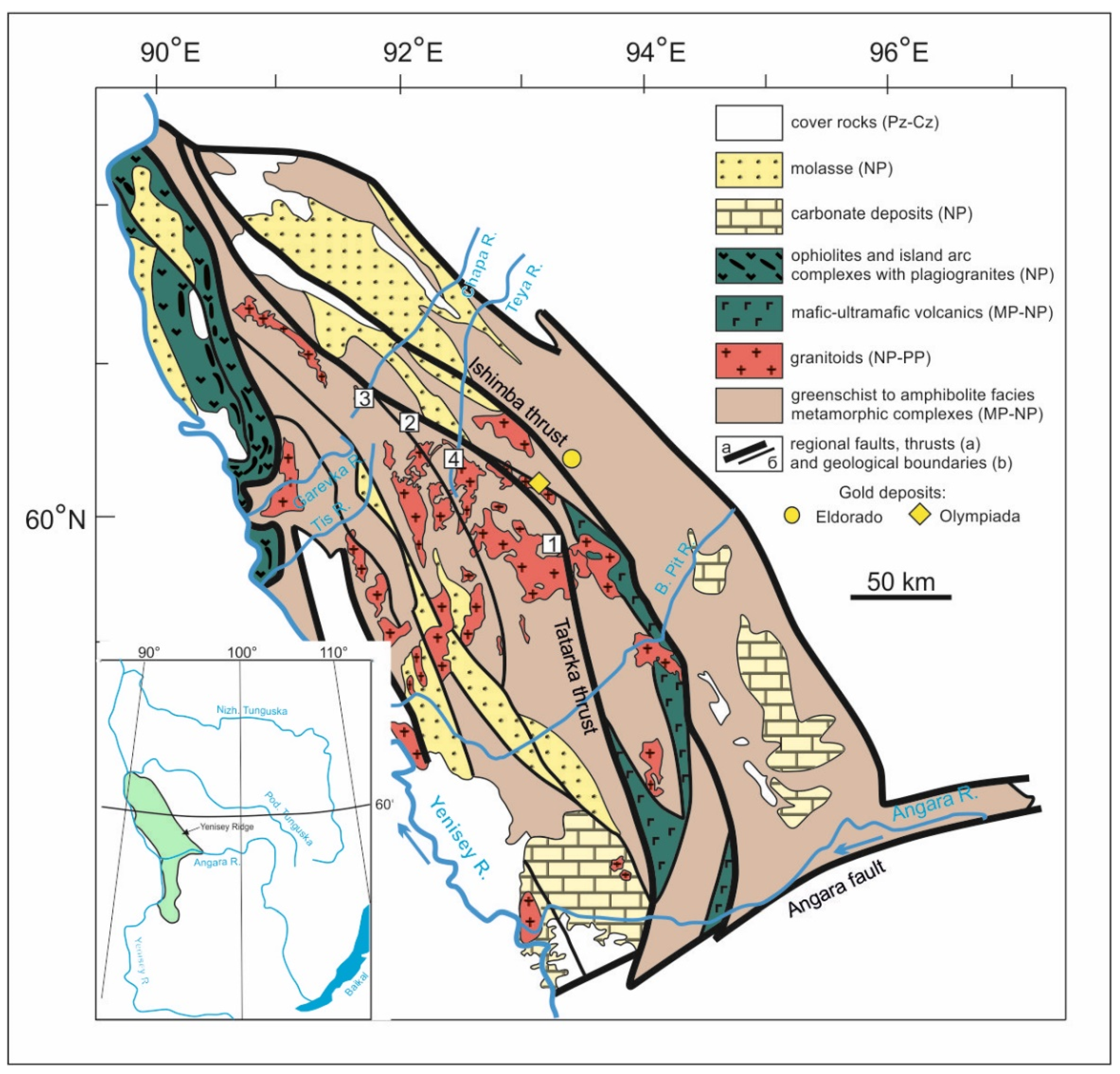



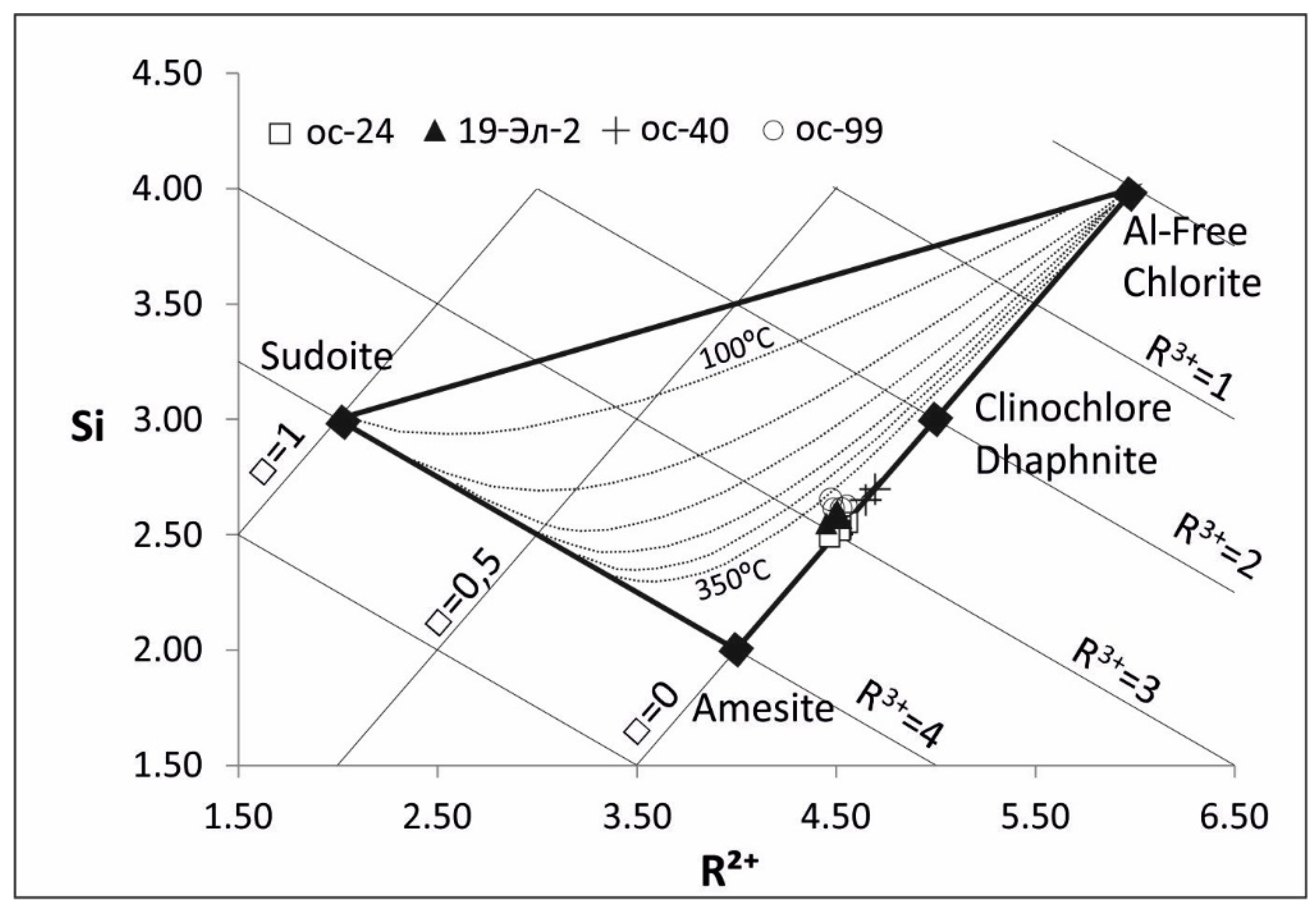
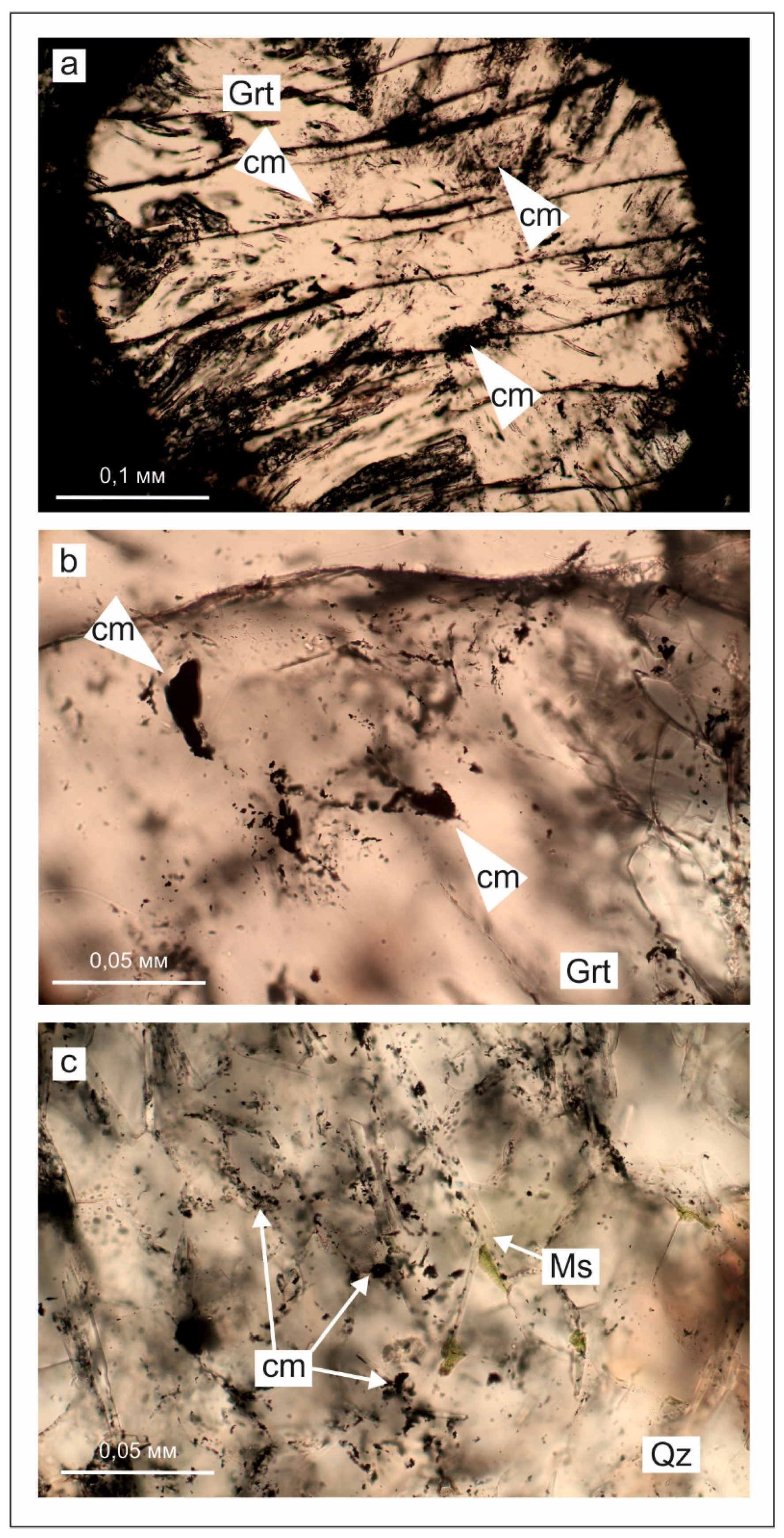
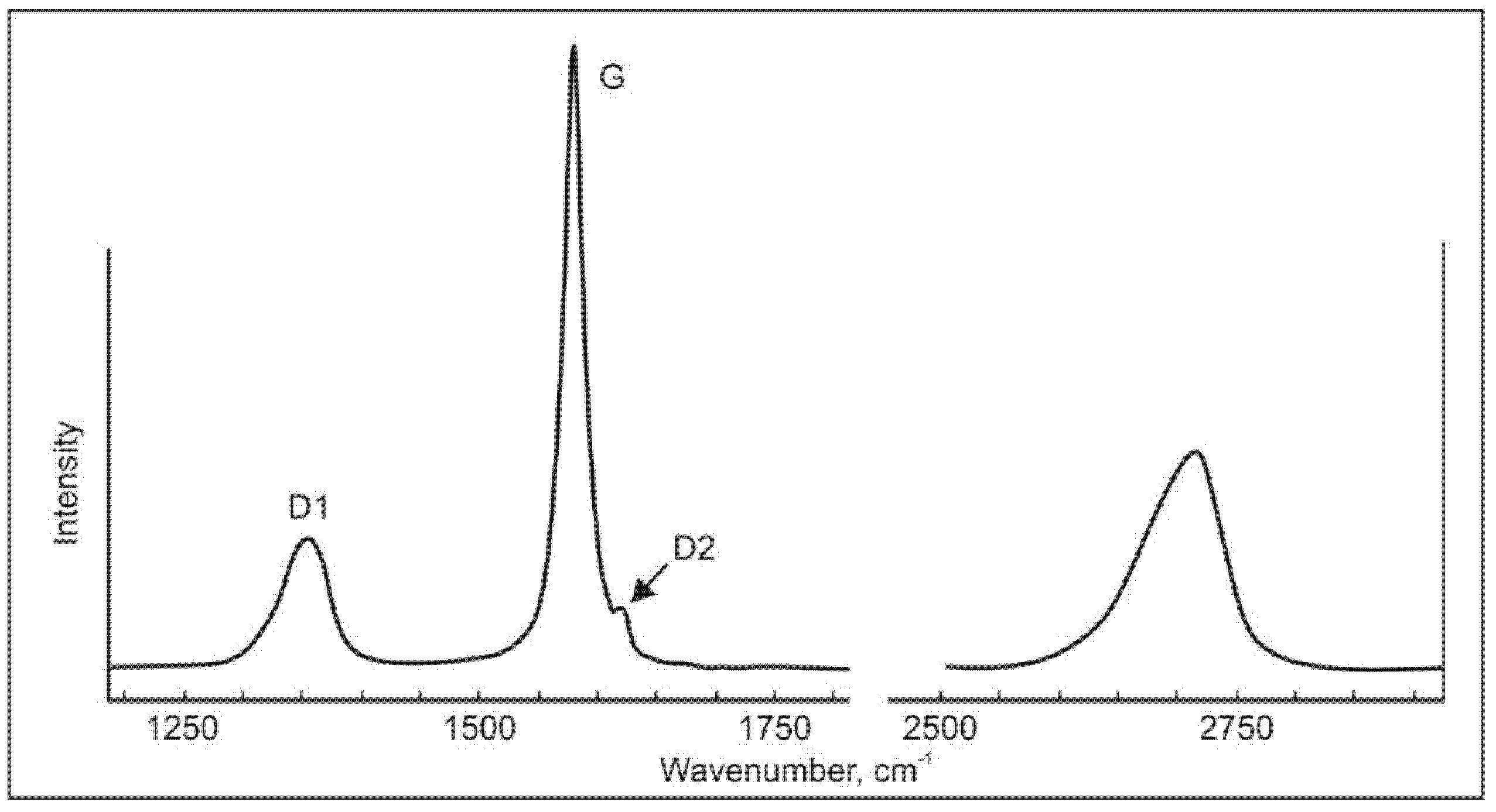
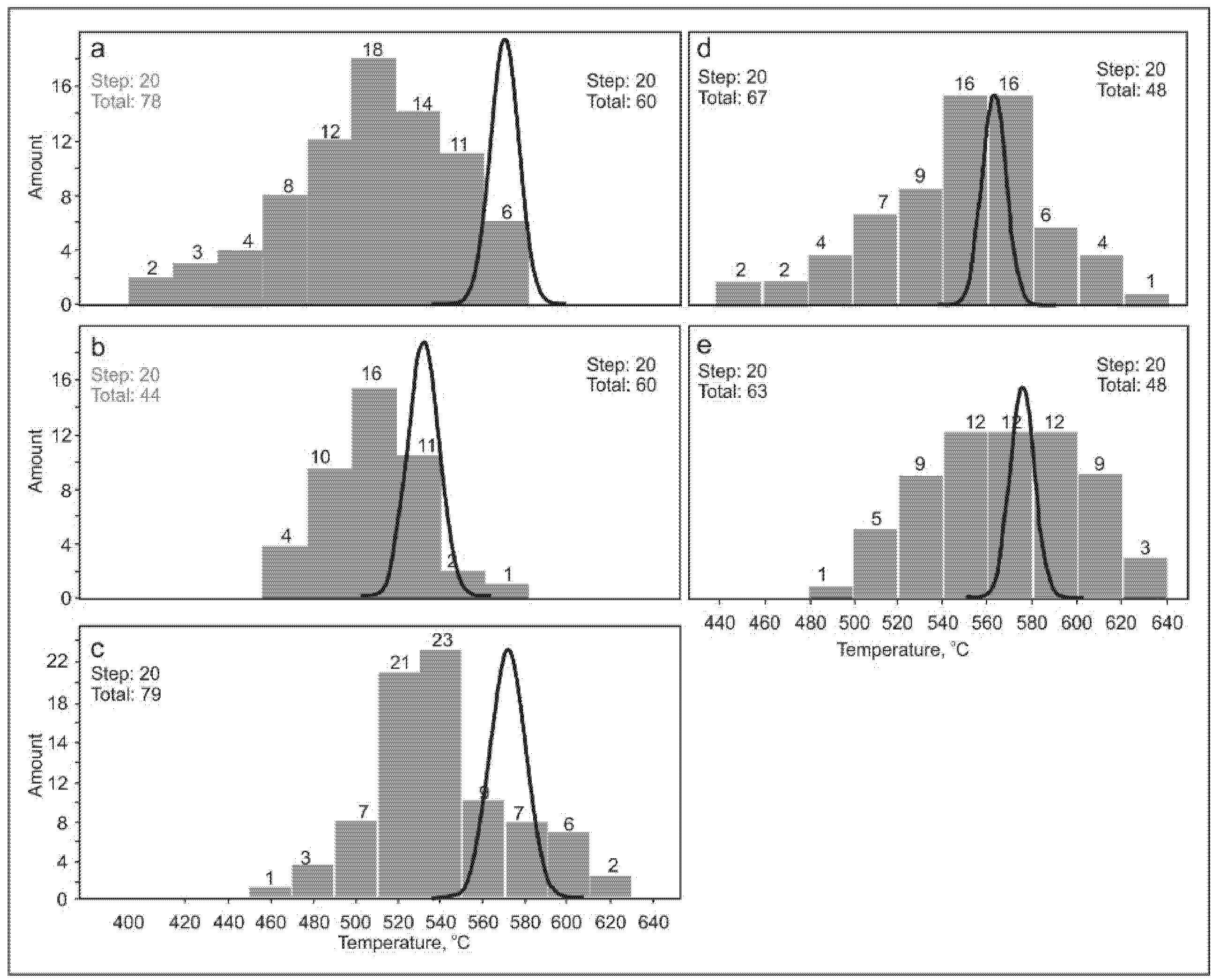
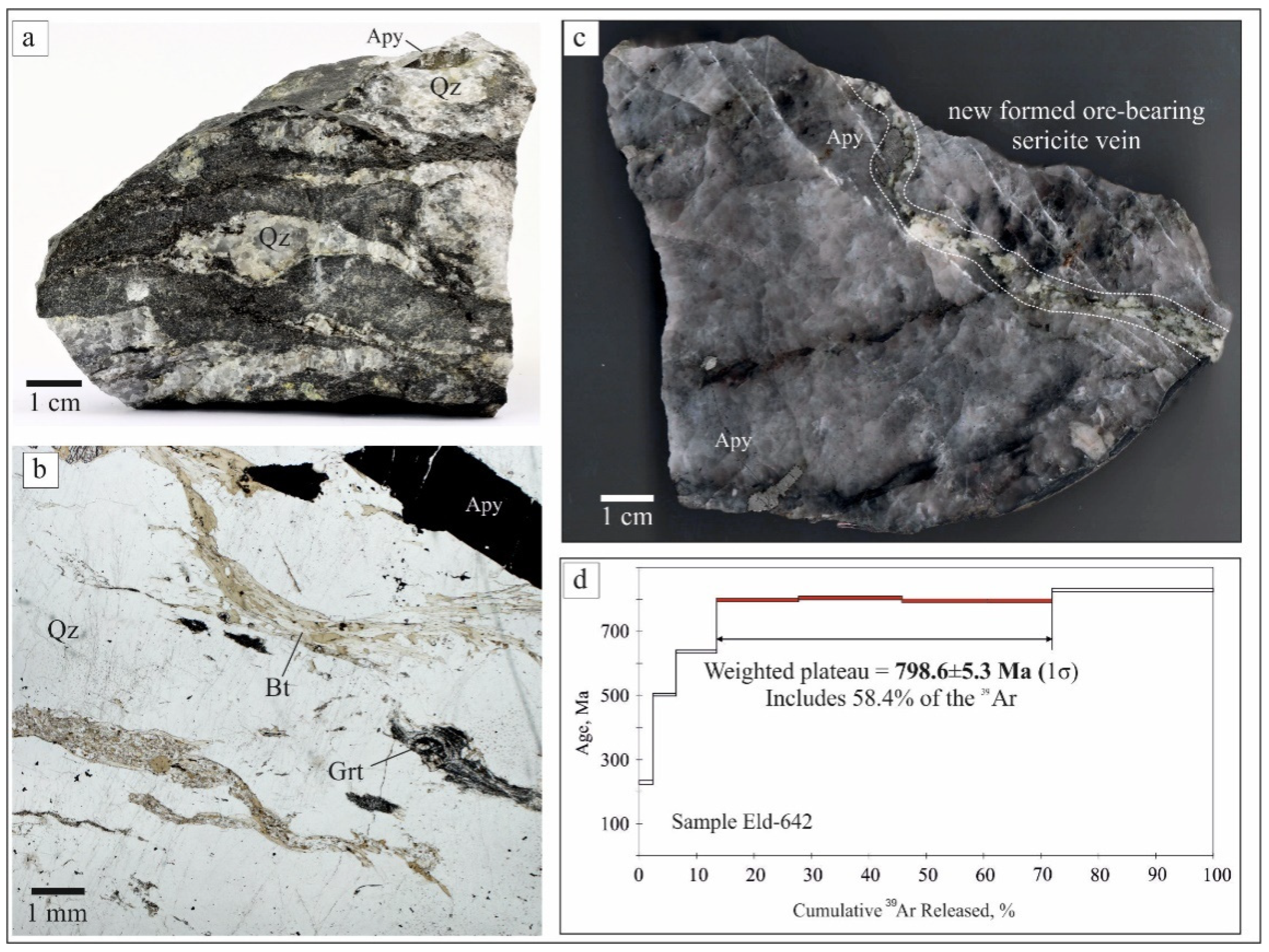
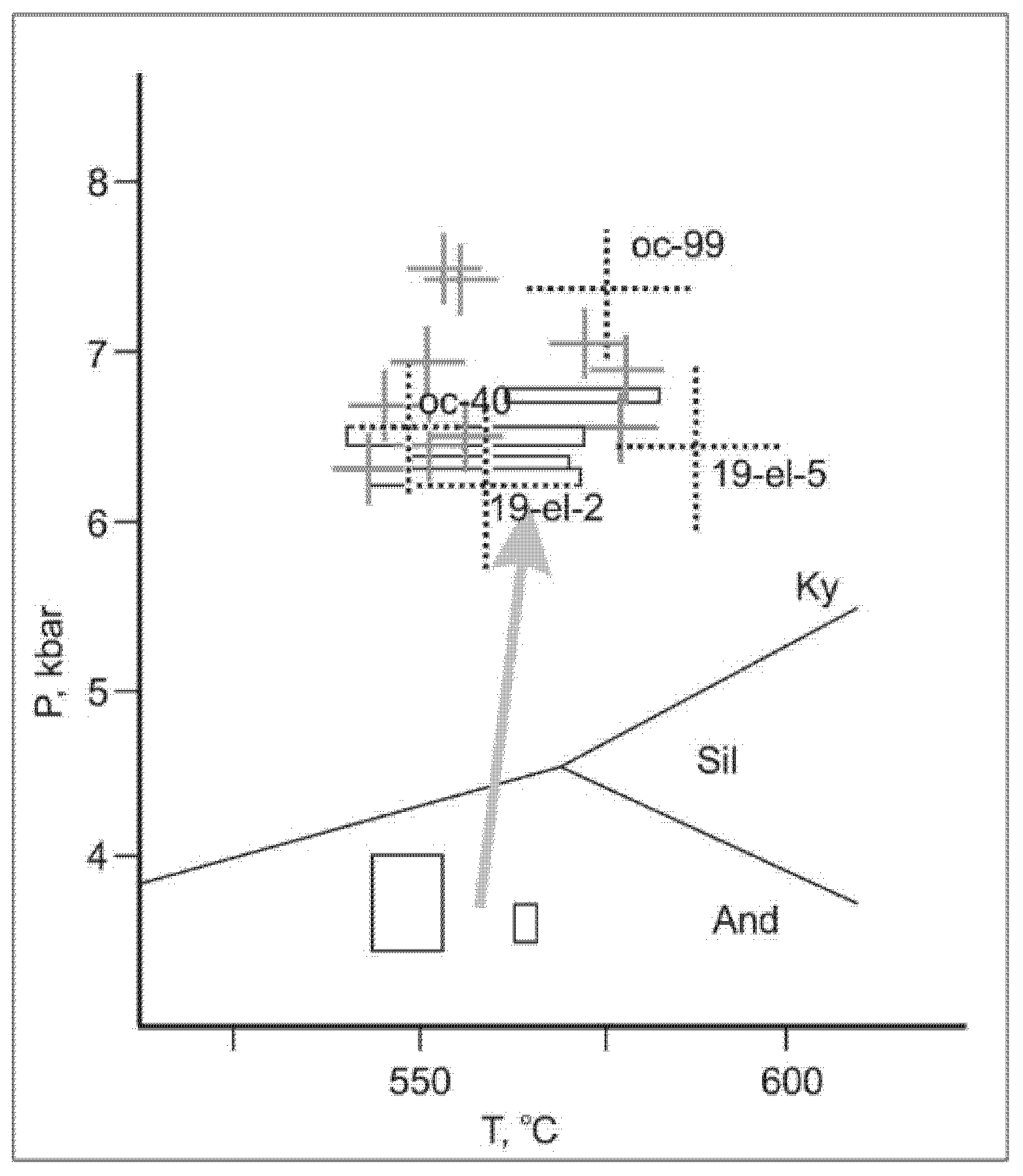
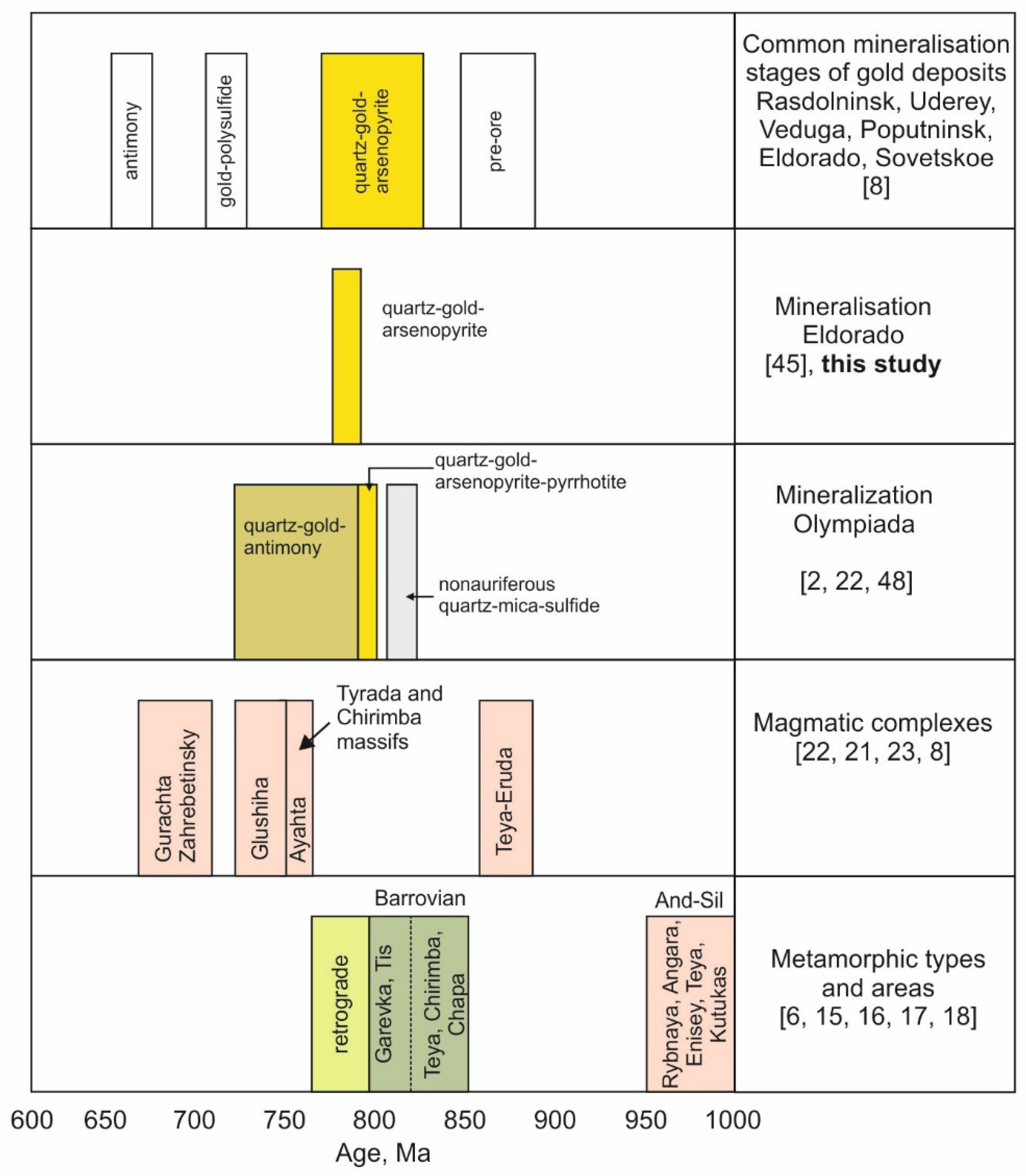
| Sample | OC-24 | OC-40 | OC-99 | 19-EL-2 | 19-EL-5 | |||||||||||||||||||
|---|---|---|---|---|---|---|---|---|---|---|---|---|---|---|---|---|---|---|---|---|---|---|---|---|
| Grt r | Grt c | Grt r | Ms | Cld | St | Grt 1 r | Grt 1 c | Grt 1 r | Pl | Grt r | Grt c | Grt r | Pl | Grt r | Grt c | Grt r | Ms | Pl | Grt r | Grt c | Grt r | Ms | Pl | |
| SiO2 | 36.97 | 37.11 | 37.23 | 46.88 | 24.62 | 28.43 | 36.74 | 37.29 | 37.38 | 58.66 | 37.09 | 36.67 | 36.83 | 62.03 | 36.97 | 36.99 | 37.10 | 46.61 | 63.99 | 36.88 | 36.63 | 36.96 | 46.16 | 64.44 |
| TiO2 | 0.07 | 0.06 | 0.02 | 0.31 | 0.02 | 0.42 | 0.06 | 0.12 | 0.06 | 0.01 | 0.03 | 0.14 | 0.04 | 0.01 | 0.02 | 0.05 | 0.02 | 0.28 | 0.00 | 0.00 | 0.06 | 0.04 | 0.38 | 0.00 |
| Al2O3 | 20.89 | 20.79 | 21.25 | 35.43 | 40.88 | 54.70 | 20.63 | 20.54 | 20.58 | 25.79 | 20.63 | 20.30 | 20.50 | 23.89 | 20.47 | 20.54 | 20.81 | 35.55 | 21.59 | 20.61 | 20.37 | 20.22 | 35.43 | 21.83 |
| Cr2O3 | 0.00 | 0.00 | 0.03 | 0.03 | 0.03 | 0.04 | 0.04 | 0.00 | 0.00 | 0.01 | 0.01 | 0.03 | 0.02 | 0.01 | 0.02 | 0.00 | 0.01 | 0.02 | 0.00 | 0.00 | 0.01 | 0.03 | 0.01 | 0.00 |
| FeO | 36.31 | 34.44 | 35.77 | 1.18 | 25.23 | 12.48 | 28.38 | 21.40 | 27.71 | 0.14 | 34.16 | 26.58 | 34.39 | 0.14 | 36.68 | 29.83 | 35.31 | 1.08 | 0.04 | 35.26 | 28.90 | 36.69 | 1.85 | 0.07 |
| MnO | 0.25 | 1.98 | 0.22 | 0.01 | 0.03 | 0.01 | 6.35 | 15.12 | 7.01 | 0.01 | 2.48 | 11.22 | 1.68 | 0.00 | 2.00 | 9.24 | 3.45 | 0.01 | 0.00 | 2.91 | 11.67 | 2.28 | 0.00 | 0.00 |
| MgO | 2.36 | 1.42 | 1.93 | 0.60 | 2.62 | 0.91 | 1.39 | 0.70 | 1.29 | 0.00 | 1.58 | 1.02 | 1.63 | 0.00 | 1.95 | 1.32 | 1.74 | 0.56 | 0.00 | 1.60 | 1.16 | 1.92 | 0.73 | 0.00 |
| CaO | 3.30 | 4.49 | 3.34 | 0.00 | 0.01 | 0.01 | 6.00 | 5.18 | 5.90 | 7.92 | 4.04 | 3.25 | 4.23 | 5.24 | 1.96 | 1.89 | 2.18 | 0.00 | 4.09 | 2.88 | 0.91 | 2.33 | 0.00 | 4.10 |
| Na2O | 0.06 | 0.10 | 0.06 | 1.26 | 0.03 | 0.01 | 0.05 | 0.00 | 0.00 | 7.28 | 0.07 | 0.10 | 0.03 | 8.50 | 0.02 | 0.01 | 0.02 | 0.92 | 10.28 | 0.04 | 0.01 | 0.06 | 1.13 | 9.49 |
| K2O | 0.02 | 0.00 | 0.23 | 8.67 | 0.01 | 0.00 | 0.00 | 0.00 | 0.00 | 0.08 | 0.00 | 0.00 | 0.00 | 0.06 | 0.00 | 0.00 | 0.00 | 10.02 | 0.05 | 0.00 | 0.01 | 0.00 | 9.79 | 0.05 |
| ZnO | 0.45 | |||||||||||||||||||||||
| Mole fractions and formula units | ||||||||||||||||||||||||
| Si | 2.98 | 3.00 | 3.00 | 3.12 | 2.01 | 8.20 | 2.98 | 3.02 | 3.02 | 2.63 | 3.00 | 3.01 | 3.00 | 2.75 | 3.01 | 3.02 | 3.00 | 3.10 | 2.83 | 3.00 | 3.01 | 3.00 | 3.07 | 2.85 |
| Ti | 0.00 | 0.00 | 0.00 | 0.02 | 0.00 | 0.09 | 0.00 | 0.01 | 0.00 | 0.00 | 0.00 | 0.01 | 0.00 | 0.00 | 0.00 | 0.00 | 0.00 | 0.01 | 0.00 | 0.00 | 0.00 | 0.00 | 0.02 | 0.00 |
| Al | 1.99 | 1.98 | 2.02 | 2.78 | 3.94 | 18.60 | 1.97 | 1.96 | 1.96 | 1.36 | 1.97 | 1.96 | 1.97 | 1.25 | 1.96 | 1.97 | 1.98 | 2.78 | 1.13 | 1.97 | 1.97 | 1.94 | 2.78 | 1.14 |
| Cr | 0.00 | 0.00 | 0.00 | 0.00 | 0.00 | 0.01 | 0.00 | 0.00 | 0.00 | 0.00 | 0.00 | 0.00 | 0.00 | 0.00 | 0.00 | 0.00 | 0.00 | 0.00 | 0.00 | 0.00 | 0.00 | 0.00 | 0.00 | 0.00 |
| Fe | 2.45 | 2.33 | 2.41 | 0.07 | 1.73 | 3.01 | 1.93 | 1.45 | 1.87 | 0.01 | 2.31 | 1.82 | 2.35 | 0.01 | 2.49 | 2.03 | 2.39 | 0.06 | 0.00 | 2.40 | 1.98 | 2.49 | 0.10 | 0.00 |
| Mn | 0.02 | 0.14 | 0.02 | 0.00 | 0.00 | 0.00 | 0.44 | 1.04 | 0.48 | 0.00 | 0.17 | 0.78 | 0.12 | 0.00 | 0.14 | 0.64 | 0.24 | 0.00 | 0.00 | 0.20 | 0.81 | 0.16 | 0.00 | 0.00 |
| Mg | 0.28 | 0.17 | 0.23 | 0.06 | 0.32 | 0.39 | 0.17 | 0.08 | 0.16 | 0.00 | 0.19 | 0.13 | 0.20 | 0.00 | 0.24 | 0.16 | 0.21 | 0.06 | 0.00 | 0.19 | 0.14 | 0.23 | 0.07 | 0.00 |
| Ca | 0.29 | 0.39 | 0.29 | 0.00 | 0.00 | 0.00 | 0.52 | 0.45 | 0.51 | 0.38 | 0.35 | 0.29 | 0.37 | 0.25 | 0.17 | 0.17 | 0.19 | 0.00 | 0.19 | 0.25 | 0.08 | 0.20 | 0.00 | 0.19 |
| Na | 0.01 | 0.01 | 0.01 | 0.16 | 0.01 | 0.01 | 0.01 | 0.00 | 0.00 | 0.63 | 0.01 | 0.02 | 0.00 | 0.73 | 0.00 | 0.00 | 0.00 | 0.12 | 0.88 | 0.01 | 0.00 | 0.01 | 0.15 | 0.81 |
| K | 0.00 | 0.00 | 0.02 | 0.74 | 0.00 | 0.00 | 0.00 | 0.00 | 0.00 | 0.00 | 0.00 | 0.00 | 0.00 | 0.00 | 0.00 | 0.00 | 0.00 | 0.85 | 0.00 | 0.00 | 0.00 | 0.00 | 0.83 | 0.00 |
| Zn | 0.10 | |||||||||||||||||||||||
| F | 0.90 | 0.93 | 0.91 | 0.84 | 0.89 | 0.92 | 0.95 | 0.92 | 0.92 | 0.94 | 0.92 | 0.91 | 0.93 | 0.92 | ||||||||||
| xAlm | 0.81 | 0.77 | 0.82 | 0.63 | 0.48 | 0.62 | 0.76 | 0.60 | 0.77 | 0.82 | 0.68 | 0.79 | 0.79 | 0.66 | 0.81 | |||||||||
| xPrp/xAn | 0.09 | 0.06 | 0.08 | 0.06 | 0.03 | 0.05 | 0.37 | 0.06 | 0.04 | 0.07 | 0.25 | 0.08 | 0.05 | 0.07 | 0.18 | 0.06 | 0.05 | 0.08 | 0.19 | |||||
| xGrs/xAb | 0.09 | 0.13 | 0.10 | 0.17 | 0.15 | 0.17 | 0.62 | 0.12 | 0.09 | 0.12 | 0.74 | 0.06 | 0.06 | 0.06 | 0.82 | 0.08 | 0.03 | 0.07 | 0.81 | |||||
| xSps/xOrt | 0.01 | 0.04 | 0.01 | 0.14 | 0.34 | 0.16 | 0.00 | 0.06 | 0.26 | 0.04 | 0.00 | 0.05 | 0.21 | 0.08 | 0.00 | 0.07 | 0.27 | 0.05 | 0.00 | |||||
| Sample | OC-24 | OC-40 | OC-99 | 19-El-2 | 19-El-5 | |||||||||||||||||||||
|---|---|---|---|---|---|---|---|---|---|---|---|---|---|---|---|---|---|---|---|---|---|---|---|---|---|---|
| 1 | 2 | 3 | 4 | 5 | 1 | 2 | 3 | 4 | 5 | 1 | 2 | 3 | 4 | 5 | 1 | 2 | 3 | 4 | 5 | 6 | 1 | 2 | 3 | 4 | 5 | |
| SiO2 | 35.18 | 35.68 | 36.07 | 36.08 | 36.24 | 36.54 | 36.84 | 36.43 | 36.75 | 36.78 | 36.12 | 35.91 | 36.16 | 36.07 | 35.62 | 35.17 | 35.35 | 35.46 | 34.93 | 35.14 | 35.99 | 34.75 | 35.00 | 35.69 | 35.23 | 34.24 |
| TiO2 | 1.62 | 1.50 | 1.47 | 1.41 | 1.40 | 1.83 | 1.75 | 1.73 | 1.82 | 1.78 | 1.84 | 1.84 | 1.84 | 1.97 | 1.83 | 1.68 | 1.65 | 1.63 | 1.68 | 1.70 | 1.66 | 1.68 | 1.66 | 1.64 | 1.59 | 1.65 |
| Al2O3 | 18.58 | 18.81 | 19.16 | 19.04 | 18.93 | 17.49 | 17.98 | 18.11 | 17.74 | 17.89 | 18.39 | 18.34 | 18.39 | 18.33 | 18.26 | 18.60 | 18.71 | 18.83 | 18.69 | 18.78 | 18.88 | 18.30 | 18.28 | 18.48 | 18.73 | 18.51 |
| Cr2O3 | 0.00 | 0.04 | 0.01 | 0.01 | 0.02 | 0.02 | 0.05 | 0.07 | 0.05 | 0.05 | 0.02 | 0.02 | 0.03 | 0.04 | 0.03 | 0.09 | 0.04 | 0.06 | 0.05 | 0.02 | 0.13 | 0.02 | 0.02 | 0.00 | 0.01 | 0.02 |
| FeO | 23.82 | 21.56 | 21.36 | 21.21 | 21.27 | 20.14 | 19.74 | 20.20 | 19.58 | 20.29 | 22.86 | 23.01 | 22.69 | 22.95 | 23.45 | 22.13 | 22.02 | 21.95 | 22.55 | 22.21 | 22.03 | 23.63 | 23.48 | 22.92 | 23.15 | 23.61 |
| MnO | 0.01 | 0.00 | 0.01 | 0.01 | 0.02 | 0.26 | 0.28 | 0.30 | 0.27 | 0.28 | 0.11 | 0.11 | 0.10 | 0.08 | 0.11 | 0.03 | 0.05 | 0.04 | 0.03 | 0.05 | 0.05 | 0.04 | 0.05 | 0.04 | 0.03 | 0.04 |
| MgO | 8.41 | 9.54 | 9.36 | 9.49 | 9.56 | 9.73 | 10.07 | 10.05 | 10.05 | 9.82 | 7.43 | 7.64 | 7.54 | 7.59 | 7.79 | 8.15 | 8.16 | 8.16 | 8.22 | 8.34 | 8.00 | 7.11 | 7.21 | 7.30 | 7.46 | 7.33 |
| CaO | 0.00 | 0.00 | 0.00 | 0.00 | 0.00 | 0.00 | 0.00 | 0.01 | 0.01 | 0.00 | 0.00 | 0.00 | 0.00 | 0.00 | 0.00 | 0.00 | 0.00 | 0.00 | 0.00 | 0.00 | 0.00 | 0.00 | 0.00 | 0.00 | 0.00 | 0.01 |
| Na2O | 0.03 | 0.25 | 0.28 | 0.31 | 0.26 | 0.06 | 0.03 | 0.08 | 0.02 | 0.09 | 0.06 | 0.05 | 0.08 | 0.06 | 0.05 | 0.23 | 0.18 | 0.23 | 0.16 | 0.21 | 0.16 | 0.02 | 0.14 | 0.28 | 0.17 | 0.00 |
| K2O | 7.63 | 8.10 | 8.14 | 8.16 | 8.08 | 9.62 | 9.60 | 9.29 | 9.60 | 9.42 | 8.91 | 8.90 | 8.96 | 8.90 | 8.57 | 10.39 | 10.33 | 10.87 | 10.27 | 10.48 | 10.72 | 9.65 | 9.32 | 9.28 | 9.32 | 9.05 |
| Formula Units | ||||||||||||||||||||||||||
| Si | 2.71 | 2.71 | 2.73 | 2.73 | 2.74 | 2.78 | 2.77 | 2.75 | 2.78 | 2.77 | 2.77 | 2.75 | 2.77 | 2.76 | 2.74 | 2.70 | 2.71 | 2.70 | 2.68 | 2.68 | 2.72 | 2.71 | 2.72 | 2.75 | 2.72 | 2.69 |
| Ti | 0.09 | 0.09 | 0.08 | 0.08 | 0.08 | 0.10 | 0.10 | 0.10 | 0.10 | 0.10 | 0.11 | 0.11 | 0.11 | 0.11 | 0.11 | 0.10 | 0.09 | 0.09 | 0.10 | 0.10 | 0.09 | 0.10 | 0.10 | 0.09 | 0.09 | 0.10 |
| Al | 1.68 | 1.69 | 1.71 | 1.70 | 1.69 | 1.57 | 1.60 | 1.61 | 1.58 | 1.59 | 1.66 | 1.66 | 1.66 | 1.65 | 1.65 | 1.68 | 1.69 | 1.69 | 1.69 | 1.69 | 1.68 | 1.68 | 1.68 | 1.68 | 1.70 | 1.71 |
| Cr | 0.00 | 0.00 | 0.00 | 0.00 | 0.00 | 0.00 | 0.00 | 0.00 | 0.00 | 0.00 | 0.00 | 0.00 | 0.00 | 0.00 | 0.00 | 0.01 | 0.00 | 0.00 | 0.00 | 0.00 | 0.01 | 0.00 | 0.00 | 0.00 | 0.00 | 0.00 |
| Fe | 1.53 | 1.37 | 1.35 | 1.34 | 1.34 | 1.28 | 1.24 | 1.28 | 1.24 | 1.28 | 1.46 | 1.47 | 1.45 | 1.47 | 1.51 | 1.42 | 1.41 | 1.40 | 1.45 | 1.42 | 1.39 | 1.54 | 1.53 | 1.48 | 1.49 | 1.55 |
| Mn | 0.00 | 0.00 | 0.00 | 0.00 | 0.00 | 0.02 | 0.02 | 0.02 | 0.02 | 0.02 | 0.01 | 0.01 | 0.01 | 0.01 | 0.01 | 0.00 | 0.00 | 0.00 | 0.00 | 0.00 | 0.00 | 0.00 | 0.00 | 0.00 | 0.00 | 0.00 |
| Mg | 0.96 | 1.08 | 1.05 | 1.07 | 1.08 | 1.10 | 1.13 | 1.13 | 1.13 | 1.10 | 0.85 | 0.87 | 0.86 | 0.87 | 0.89 | 0.93 | 0.93 | 0.93 | 0.94 | 0.95 | 0.90 | 0.83 | 0.84 | 0.84 | 0.86 | 0.86 |
| Ca | 0.00 | 0.00 | 0.00 | 0.00 | 0.00 | 0.00 | 0.00 | 0.00 | 0.00 | 0.00 | 0.00 | 0.00 | 0.00 | 0.00 | 0.00 | 0.00 | 0.00 | 0.00 | 0.00 | 0.00 | 0.00 | 0.00 | 0.00 | 0.00 | 0.00 | 0.00 |
| Na | 0.00 | 0.04 | 0.04 | 0.05 | 0.04 | 0.01 | 0.00 | 0.01 | 0.00 | 0.01 | 0.01 | 0.01 | 0.01 | 0.01 | 0.01 | 0.03 | 0.03 | 0.03 | 0.02 | 0.03 | 0.02 | 0.00 | 0.02 | 0.04 | 0.02 | 0.00 |
| K | 0.75 | 0.79 | 0.78 | 0.79 | 0.78 | 0.93 | 0.92 | 0.90 | 0.93 | 0.91 | 0.87 | 0.87 | 0.88 | 0.87 | 0.84 | 1.02 | 1.01 | 1.06 | 1.00 | 1.02 | 1.04 | 0.96 | 0.93 | 0.91 | 0.92 | 0.91 |
| F | 0.61 | 0.56 | 0.56 | 0.56 | 0.56 | 0.54 | 0.52 | 0.53 | 0.52 | 0.54 | 0.63 | 0.63 | 0.63 | 0.63 | 0.63 | 0.60 | 0.60 | 0.60 | 0.61 | 0.60 | 0.61 | 0.65 | 0.65 | 0.64 | 0.64 | 0.64 |
| Temperature, °C | ||||||||||||||||||||||||||
| H2005 | 549 | 540 | 533 | 524 | 521 | 589 | 580 | 578 | 589 | 581 | 573 | 575 | 574 | 588 | 574 | 559 | 554 | 551 | 558 | 562 | 552 | 554 | 553 | 548 | 542 | 538 |
| Wu2015 | 572 | 546 | 550 | 542 | 539 | 570 | 563 | 560 | 567 | 567 | 614 | 608 | 612 | 619 | 601 | 571 | 569 | 568 | 568 | 569 | 575 | 594 | 591 | 590 | 581 | 570 |
| Sample | OC-24 | OC-40 | OC-99 | 19-EL-2 | ||||||||||||||
|---|---|---|---|---|---|---|---|---|---|---|---|---|---|---|---|---|---|---|
| 1 | 2 | 3 | 4 | 5 | 6 | 7 | 1 | 2 | 1 | 2 | 3 | 4 | 1 | 2 | 3 | 4 | 5 | |
| SiO2 | 24.000 | 23.960 | 24.400 | 24.020 | 24.120 | 23.570 | 23.350 | 26.345 | 25.716 | 24.591 | 24.983 | 24.928 | 24.733 | 24.570 | 24.520 | 24.394 | 24.673 | 24.644 |
| TiO2 | 0.065 | 0.048 | 0.071 | 0.105 | 0.056 | 0.060 | 0.044 | 0.057 | 0.071 | 0.092 | 0.071 | 0.102 | 0.113 | 0.081 | 0.115 | 0.087 | 0.053 | 0.118 |
| Al2O3 | 22.900 | 22.850 | 22.700 | 23.110 | 23.060 | 22.430 | 22.640 | 21.265 | 21.441 | 22.765 | 22.733 | 22.942 | 23.120 | 23.314 | 23.420 | 23.321 | 23.047 | 23.104 |
| Cr2O3 | 0.024 | 0.014 | 0.000 | 0.036 | 0.020 | 0.024 | 0.023 | 0.020 | 0.054 | 0.064 | 0.031 | 0.063 | 0.028 | 0.000 | 0.031 | 0.035 | 0.048 | 0.000 |
| FeOtotal | 29.800 | 30.160 | 29.670 | 29.160 | 29.820 | 29.620 | 29.500 | 27.481 | 28.511 | 30.393 | 31.199 | 30.415 | 30.575 | 29.476 | 29.599 | 29.925 | 29.515 | 28.661 |
| MnO | 0.024 | 0.013 | 0.008 | 0.017 | 0.018 | 0.005 | 0.022 | 0.465 | 0.553 | 0.173 | 0.205 | 0.177 | 0.177 | 0.070 | 0.068 | 0.067 | 0.073 | 0.089 |
| MgO | 12.320 | 12.630 | 13.140 | 12.890 | 12.550 | 12.610 | 12.690 | 15.227 | 14.463 | 11.582 | 11.504 | 11.198 | 11.295 | 12.302 | 12.330 | 12.285 | 12.251 | 12.495 |
| CaO | 0.011 | 0.000 | 0.001 | 0.000 | 0.022 | 0.012 | 0.000 | 0.028 | 0.009 | 0.019 | 0.000 | 0.031 | 0.008 | 0.015 | 0.016 | 0.010 | 0.043 | 0.030 |
| Na2O | 0.032 | 0.000 | 0.000 | 0.078 | 0.029 | 0.000 | 0.063 | 0.049 | 0.000 | 0.034 | 0.000 | 0.000 | 0.029 | 0.025 | 0.000 | 0.193 | 0.204 | 0.000 |
| K2O | 0.003 | 0.011 | 0.002 | 0.000 | 0.011 | 0.003 | 0.000 | 0.006 | 0.038 | 0.000 | 0.000 | 0.011 | 0.012 | 0.046 | 0.000 | 0.086 | 0.045 | 0.032 |
| Total | 89.177 | 89.685 | 89.991 | 89.416 | 89.706 | 88.334 | 88.332 | 90.943 | 90.856 | 89.713 | 90.726 | 89.867 | 90.090 | 89.899 | 90.099 | 90.403 | 89.952 | 89.173 |
| Cations Based on 14 oxygen | ||||||||||||||||||
| Si | 2.541 | 2.522 | 2.552 | 2.525 | 2.536 | 2.517 | 2.489 | 2.697 | 2.651 | 2.603 | 2.622 | 2.640 | 2.611 | 2.579 | 2.569 | 2.545 | 2.586 | 2.602 |
| Al(IV) | 1.459 | 1.478 | 1.448 | 1.475 | 1.464 | 1.483 | 1.511 | 1.303 | 1.349 | 1.397 | 1.378 | 1.360 | 1.389 | 1.421 | 1.431 | 1.455 | 1.414 | 1.398 |
| ∑T sites | 4.000 | 4.000 | 4.000 | 4.000 | 4.000 | 4.000 | 4.000 | 4.000 | 4.000 | 4.000 | 4.000 | 4.000 | 4.000 | 4.000 | 4.000 | 4.000 | 4.000 | 4.000 |
| Al(VI) | 1.399 | 1.356 | 1.350 | 1.388 | 1.393 | 1.339 | 1.333 | 1.263 | 1.256 | 1.444 | 1.435 | 1.504 | 1.488 | 1.463 | 1.461 | 1.412 | 1.432 | 1.477 |
| Fe(3+) | 0.054 | 0.115 | 0.088 | 0.083 | 0.067 | 0.133 | 0.182 | 0.040 | 0.083 | 0.000 | 0.000 | 0.000 | 0.000 | 0.000 | 0.000 | 0.077 | 0.017 | 0.000 |
| Fe(2+) | 2.584 | 2.540 | 2.507 | 2.480 | 2.555 | 2.511 | 2.448 | 2.313 | 2.375 | 2.691 | 2.739 | 2.694 | 2.699 | 2.587 | 2.594 | 2.533 | 2.570 | 2.531 |
| Mn | 0.002 | 0.001 | 0.001 | 0.002 | 0.002 | 0.000 | 0.002 | 0.040 | 0.048 | 0.016 | 0.018 | 0.016 | 0.016 | 0.006 | 0.006 | 0.006 | 0.006 | 0.008 |
| Mg | 1.945 | 1.982 | 2.049 | 2.020 | 1.967 | 2.007 | 2.017 | 2.324 | 2.222 | 1.828 | 1.800 | 1.768 | 1.778 | 1.925 | 1.926 | 1.910 | 1.914 | 1.967 |
| Ti | 0.005 | 0.004 | 0.006 | 0.008 | 0.004 | 0.005 | 0.003 | 0.004 | 0.006 | 0.007 | 0.006 | 0.008 | 0.009 | 0.006 | 0.009 | 0.007 | 0.004 | 0.009 |
| Cr | 0.002 | 0.001 | 0.000 | 0.003 | 0.002 | 0.002 | 0.002 | 0.002 | 0.004 | 0.005 | 0.003 | 0.005 | 0.002 | 0.000 | 0.003 | 0.003 | 0.004 | 0.000 |
| ∑O sites | 5.992 | 5.998 | 6.000 | 5.984 | 5.990 | 5.998 | 5.987 | 5.986 | 5.994 | 5.991 | 6.000 | 5.995 | 5.992 | 5.987 | 5.998 | 5.948 | 5.948 | 5.992 |
| Oct vacancy | 0.008 | 0.002 | 0.000 | 0.016 | 0.010 | 0.002 | 0.013 | 0.014 | 0.006 | 0.009 | 0.000 | 0.005 | 0.008 | 0.013 | 0.002 | 0.052 | 0.052 | 0.008 |
| R(2+) | 4.531 | 4.523 | 4.557 | 4.502 | 4.523 | 4.519 | 4.466 | 4.678 | 4.645 | 4.534 | 4.557 | 4.478 | 4.493 | 4.518 | 4.525 | 4.449 | 4.490 | 4.506 |
| R(3+) | 1.461 | 1.476 | 1.443 | 1.483 | 1.467 | 1.479 | 1.521 | 1.309 | 1.349 | 1.457 | 1.443 | 1.517 | 1.499 | 1.469 | 1.473 | 1.499 | 1.458 | 1.487 |
| Ca | 0.001 | 0.000 | 0.000 | 0.000 | 0.002 | 0.001 | 0.000 | 0.003 | 0.001 | 0.002 | 0.000 | 0.004 | 0.001 | 0.002 | 0.002 | 0.001 | 0.005 | 0.003 |
| Na | 0.007 | 0.000 | 0.000 | 0.016 | 0.006 | 0.000 | 0.013 | 0.010 | 0.000 | 0.007 | 0.000 | 0.000 | 0.006 | 0.005 | 0.000 | 0.039 | 0.041 | 0.000 |
| K | 0.000 | 0.002 | 0.000 | 0.000 | 0.001 | 0.000 | 0.000 | 0.001 | 0.005 | 0.000 | 0.000 | 0.001 | 0.002 | 0.006 | 0.000 | 0.011 | 0.006 | 0.004 |
| Fe/(Fe*Mg) | 0.576 | 0.573 | 0.559 | 0.559 | 0.571 | 0.569 | 0.566 | 0.503 | 0.525 | 0.595 | 0.603 | 0.604 | 0.603 | 0.573 | 0.574 | 0.577 | 0.575 | 0.563 |
| Chlorite Crystallisation Temperature | ||||||||||||||||||
| ME (°C) | 406 | 411 | 402 | 411 | 408 | 412 | 419 | 356 | 370 | 390 | 384 | 381 | 389 | 397 | 400 | 404 | 393 | 391 |
| CN (°C) | 326 | 329 | 323 | 329 | 327 | 330 | 335 | 293 | 302 | 315 | 311 | 310 | 315 | 320 | 322 | 325 | 317 | 316 |
| KM (°C) | 369 | 372 | 365 | 371 | 369 | 372 | 377 | 331 | 341 | 359 | 356 | 354 | 359 | 363 | 365 | 368 | 360 | 358 |
| J (°C) | 413 | 418 | 408 | 417 | 414 | 419 | 426 | 361 | 376 | 397 | 392 | 389 | 397 | 404 | 407 | 411 | 400 | 398 |
| Sample | T, °C | P, kbar | |
|---|---|---|---|
| Ti-in-Bt | Grt-Bt | Grt-Bt-Pl-Qtz | |
| OC107 | 577 | 540 | 6.3 |
| OC05 | 560 | 580 | 6.5 |
| OC06 | 570 | 545 | 6.7 |
| OC95 | 590 | 555 | 7.4 |
| OC99 | 595 | 550 | 6.9 |
| OC100 | 565 | 565 | 6.6 |
| OC102 | 585 | 575 | 6.8 |
| OC119 | 560 | 570 | 7.2 |
| OC120 | 580 | 550 | 6.5 |
| OC49 | 590 | 565 | 7.4 |
| Sample | n | D1 | G | D2 | R1 | R2 | Temperature (°C) | ||||||||||||||||
|---|---|---|---|---|---|---|---|---|---|---|---|---|---|---|---|---|---|---|---|---|---|---|---|
| Position | FWHM | Position | FWHM | Position | FWHM | Beyssac et al. [2] | Rahl et al. [43] | ||||||||||||||||
| Mean | SE | Mean | SE | Mean | Se | Mean | Se | Mean | Se | Mean | Se | Mean | Se | Mean | Se | Mean | Min | Max | Mean | Min | Max | ||
| oc-24 | 78 | 1350.0 | 3.7 | 46.4 | 1.4 | 1576.0 | 2.3 | 20.0 | 1.3 | 1616.5 | 2.7 | 14.8 | 3.7 | 0.3 | 0.1 | 0.3 | 0.1 | 508 | 413 | 579 | 495 | 374 | 617 |
| oc-40 | 44 | 1353.4 | 2.4 | 45.1 | 1.4 | 1576.5 | 1.4 | 21.1 | 2.5 | 1617.2 | 1.9 | 11.8 | 2.6 | 0.3 | 0.1 | 0.3 | 0.0 | 511 | 470 | 562 | 504 | 437 | 588 |
| oc-99 | 79 | 1353.8 | 2.7 | 44.1 | 1.5 | 1577.7 | 1.4 | 19.7 | 1.8 | 1618.9 | 1.9 | 11.0 | 2.2 | 0.2 | 0.1 | 0.2 | 0.1 | 539 | 461 | 612 | 548 | 428 | 681 |
| 19-El-2 | 67 | 1355.2 | 3.1 | 44.2 | 2.7 | 1577.0 | 2.0 | 17.6 | 1.0 | 1600.0 | 34.2 | 12.6 | 3.7 | 0.2 | 0.1 | 0.2 | 0.1 | 546 | 451 | 607 | 558 | 400 | 670 |
| 19-El-5 | 63 | 1352.2 | 4.3 | 44.2 | 2.8 | 1574.8 | 3.4 | 18.5 | 1.8 | 1615.0 | 4.1 | 14.2 | 3.3 | 0.1 | 0.1 | 0.2 | 0.1 | 561 | 496 | 611 | 586 | 477 | 678 |
| Heating Step | T (°C) | 40Ar/39Ar | ±1σ | 38Ar/39Ar | ±1σ | 37Ar/39Ar | ±1σ | 36Ar/39Ar | ±1σ | Ca/K | ∑39Ar (%) | Age, Ma | ±1σ |
|---|---|---|---|---|---|---|---|---|---|---|---|---|---|
| Sample Eld-642 (sericite), Weight = 8.8 mg, J = 0.003175 ± 0.000026 | |||||||||||||
| 1 | 500 | 71.3 | 0.141 | 0.086 | 0.00216 | 1103.652 | 70.38 | 0.0974 | 0.00395 | 3973.1 | 2.4 | 228.7 | 6.2 |
| 2 | 600 | 116.7 | 0.18 | 0.06 | 0.00135 | 716.613 | 39.93 | 0.0531 | 0.00164 | 2579.8 | 6.4 | 502 | 4.2 |
| 3 | 700 | 150.7 | 0.255 | 0.049 | 0.00082 | 521.11 | 16.63 | 0.0592 | 0.00142 | 1876 | 13.5 | 636.4 | 4.8 |
| 4 | 750 | 177.5 | 0.129 | 0.023 | 0.00068 | 158.15 | 16.39 | 0.0074 | 0.00109 | 569.34 | 27.8 | 798.3 | 5.4 |
| 5 | 800 | 180.6 | 0.103 | 0.023 | 0.00054 | 65.813 | 12.22 | 0.0121 | 0.00077 | 236.93 | 45.8 | 804.4 | 5.4 |
| 6 | 900 | 180.3 | 0.124 | 0.028 | 0.00049 | 220.31 | 17.23 | 0.0193 | 0.00059 | 793.12 | 60.7 | 795.8 | 5.3 |
| 7 | 1000 | 180.7 | 0.171 | 0.028 | 0.00067 | 134.609 | 24.06 | 0.0207 | 0.00153 | 484.6 | 71.9 | 795.6 | 5.6 |
| 8 | 1130 | 191.1 | 0.087 | 0.024 | 0.00035 | 71.454 | 8.19 | 0.0248 | 0.00054 | 257.2 | 100 | 829.3 | 5.5 |
Publisher’s Note: MDPI stays neutral with regard to jurisdictional claims in published maps and institutional affiliations. |
© 2021 by the authors. Licensee MDPI, Basel, Switzerland. This article is an open access article distributed under the terms and conditions of the Creative Commons Attribution (CC BY) license (https://creativecommons.org/licenses/by/4.0/).
Share and Cite
Sukhorukov, V.; Volkova, V.; Nevolko, P.; Kozlov, P. Metamorphic Conditions and Raman Spectroscopic Carbonaceous Material Thermometry of Host Schists of Olympiada and Eldorado Gold Deposits (Yenisey Ridge, Russia). Geosciences 2021, 11, 452. https://doi.org/10.3390/geosciences11110452
Sukhorukov V, Volkova V, Nevolko P, Kozlov P. Metamorphic Conditions and Raman Spectroscopic Carbonaceous Material Thermometry of Host Schists of Olympiada and Eldorado Gold Deposits (Yenisey Ridge, Russia). Geosciences. 2021; 11(11):452. https://doi.org/10.3390/geosciences11110452
Chicago/Turabian StyleSukhorukov, Vasiliy, Valeriya Volkova, Peter Nevolko, and Pavel Kozlov. 2021. "Metamorphic Conditions and Raman Spectroscopic Carbonaceous Material Thermometry of Host Schists of Olympiada and Eldorado Gold Deposits (Yenisey Ridge, Russia)" Geosciences 11, no. 11: 452. https://doi.org/10.3390/geosciences11110452
APA StyleSukhorukov, V., Volkova, V., Nevolko, P., & Kozlov, P. (2021). Metamorphic Conditions and Raman Spectroscopic Carbonaceous Material Thermometry of Host Schists of Olympiada and Eldorado Gold Deposits (Yenisey Ridge, Russia). Geosciences, 11(11), 452. https://doi.org/10.3390/geosciences11110452





